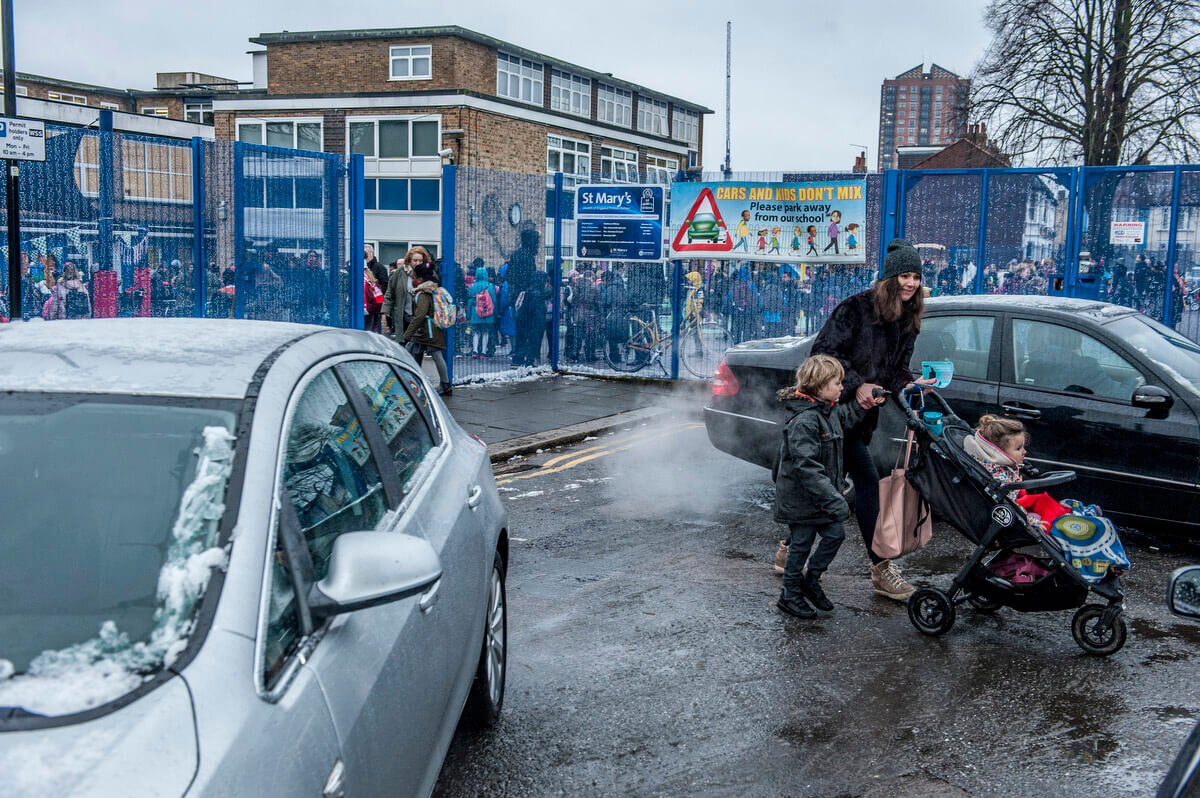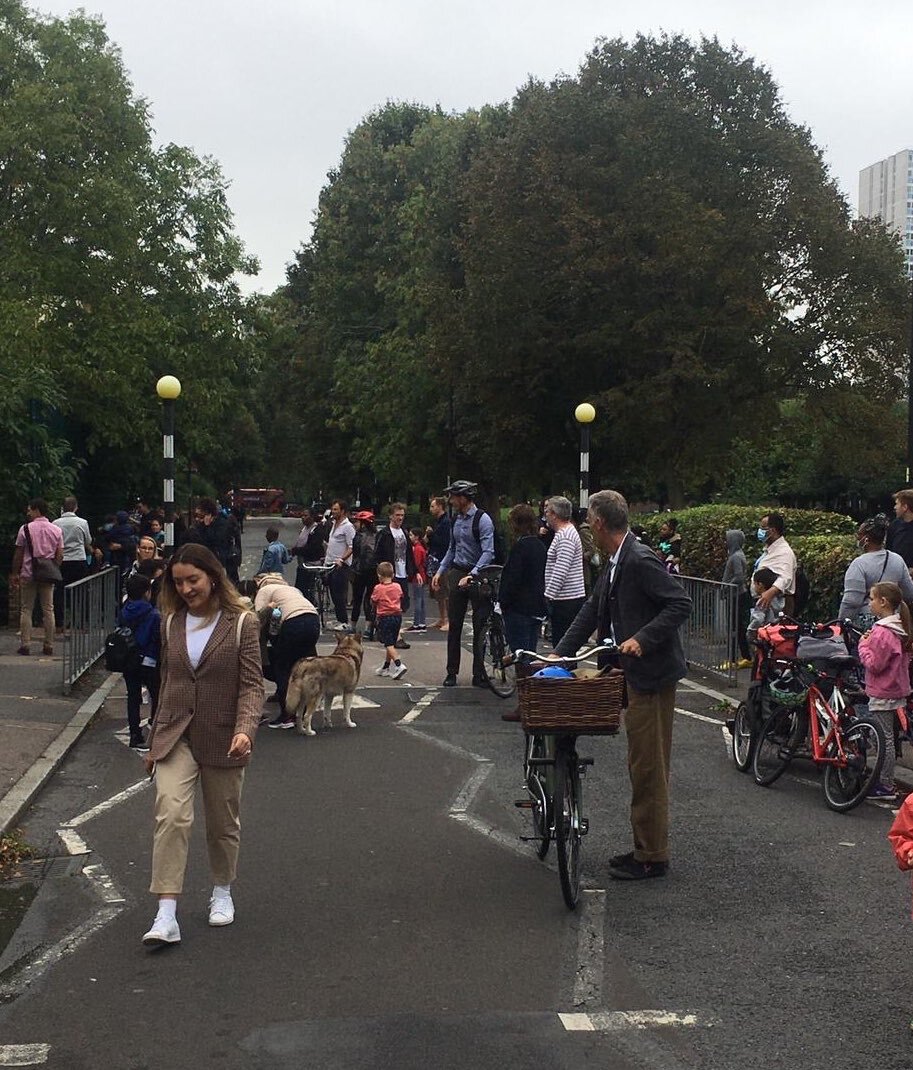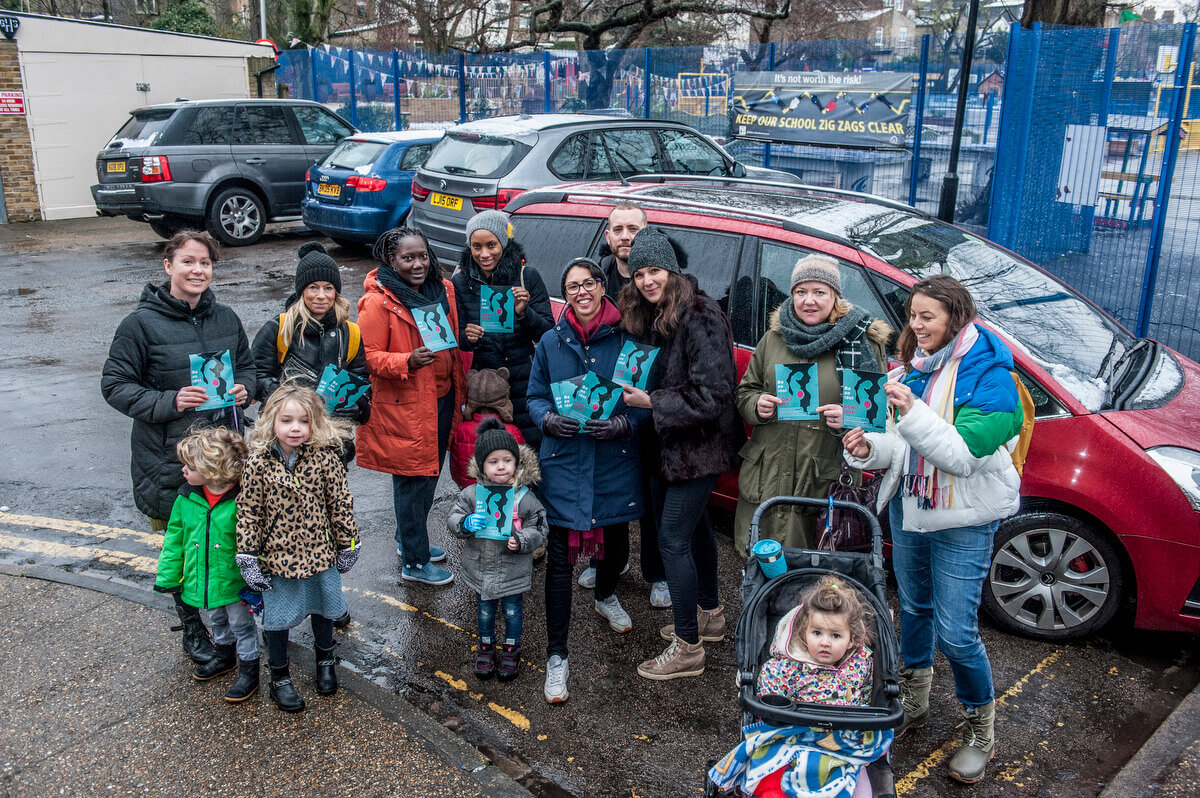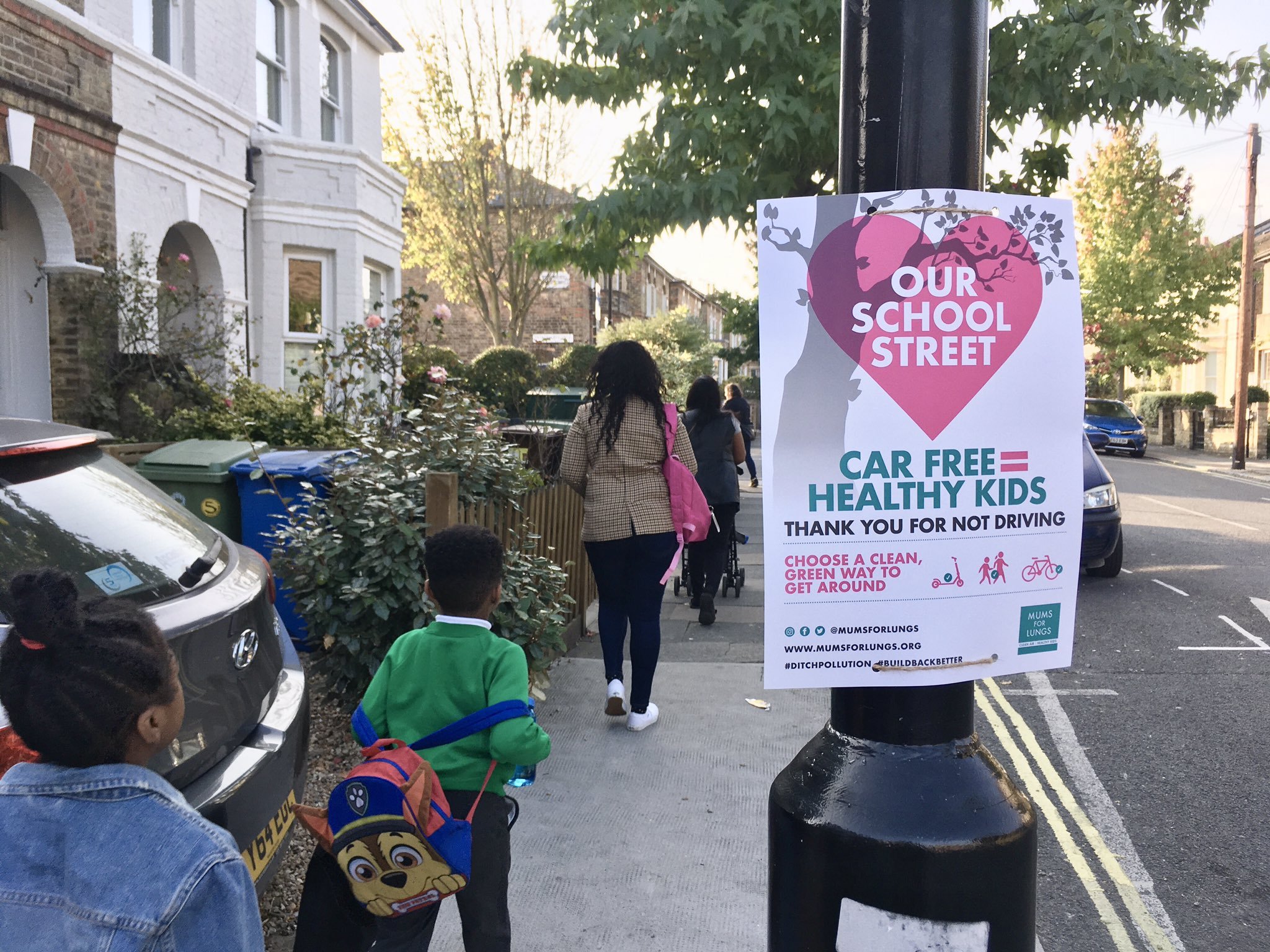
School Streets
A pioneering initiative to transform the roads around schools
What is a School Street?
It’s a simple idea — a School Street temporarily restricts motor traffic around schools at drop-off and pick-up times, allowing children to walk, cycle or scoot more safely to school. Signs are put up to inform drivers of the restriction, and barriers or cameras can be used to enforce it. Residents, local businesses, and blue badge holders are able to apply for exemptions.
Photo credit: School Streets project at Jessop Primary in Lambeth, Councillor Claire Holland

“It makes a real difference to the experience of getting to school. We don’t have to stand at the side of the road breathing in fumes and waiting while cars go past. We can stand and chat at the school gates.”
Why are School Streets good?
School Streets change our streets for the better
Those of us who pass schools during the morning rush hour know how polluted, busy and dangerous the surrounding roads can be. 40% of primary school children are driven to school in England and 25% of pupils in Inner London are driven to school every day.
Closing the roads around schools to motor traffic is a powerful way to show that roads can be reclaimed, and makes the alternatives such as cycling and walking more attractive.
School Streets reduce air pollution and make streets safer
School Streets are proven to reduce air pollution around a school - research shows nitrogen dioxide levels reduce by up to 23 per cent where there is a School Street.
They also make it safer to walk, cycle and scoot to school, creating a more pleasant environment and giving children a chance to get some exercise. Travelling actively improves mood, behaviour and confidence, increases attention levels and enhances performance.
School Streets raise awareness of the need to reduce vehicles
Children are exposed to up to five times more air pollution on the school run than at any other time, and the links between pollution and health problems are well known.
School Streets show the local community the difference that can happen when streets are less dominated by cars, and the need to reduce traffic rates more generally. By reducing driving rates and pollution, children are given space to breathe, families space to play and communities space to connect.
School Streets in London
In 2019 there were about 85 School Streets in London. Most local authorities had just one or two School Streets; Croydon and Islington were leading the charge with thirteen schemes, closely followed by Hackney, Southwark, Camden and Greenwich.
In 2020 the Covid19 pandemic meant a shift in the way people thought about road space and many more School Streets were created. As of early 2025, over 700 School Streets are in place across London, with more on the way, which is an incredible achievement!
We were delighted to hear that Lambeth Council have announced that 90 per cent of their primary schools will have a School Street by November 2025, and are starting to revise their original School Streets to ensure they are as effective as they can be.
A School Street at Honeywell Primary School, Clapham
School Streets outside London
There are far fewer School Streets outside London, we estimate around 200 across the country.
Our School Streets report with Possible, the Active Travel Academy and Transport for Quality of Life assessed the future potential for School Streets in four cities: London, Birmingham, Leeds and Bristol. It found that:
"a comprehensive roll-out of School Streets in the four cities would reduce exposure to air pollution and road danger for 1.25 million primary and secondary students.”
A School Street at Acacias Community Primary School, Manchester
So what’s holding the scheme back outside London?
Partly it is due to funding issues and a slow uptake from local authorities for the powers to enforce School Streets with cameras. Derby Council was one of the first to apply for the powers for their School Streets and now has 12 schemes in place. Liverpool Council has committed to setting up 50 School Streets in the coming years, and Greater Manchester Mayor Andy Burnham has committed to implementing 100 School Streets across Greater Manchester by 2028.
Government guidance on setting up a School Street
In November 2024 the Government published guidance for local authorities on how to set up a School Street. We welcome this blueprint for School Streets, as for many years local authorities have been implementing the scheme in various ways, either with volunteer enforcement, camera enforcement or without any enforcement at all. We hope this guidance will inspire local authorities all over the country to implement many more schemes over the coming years.

“Before it was introduced, it was really stressful taking the children to school. It was total chaos. Now my kids say they feel much calmer coming to school.”
The benefits of School Streets
We’ve created a short film to show you the benefits of School Streets.
Thanks to the teachers and parents of Jessop Primary School in Lambeth for taking part in this film.

“A School Streets trial at a primary school in Eltham resulted in a 54% reduction in cars driving to school, a 27% increase in cycling and 9% increase in scooting.”
How to campaign for a School Street
-

RAISE AWARENESS
We offer support to parents and teachers in contacting local authorities to ask for new School Streets schemes.
We’ve written a briefing document for parents who would like to know more about School Streets and how to get one, and a template letter, which you can adapt accordingly, to help you present your case for the scheme to your school and council. You can find both of these in our Resources section.
-

SPREAD THE WORD
You can help to raise awareness of School Streets by chatting to other parents and discussing the issue at Parent Teacher Association meetings.
We’ve created a School Streets flyer that you can print and hand out, or ask your school to send out by email.
If you think there is support for the idea, please contact your headteacher and suggest they ask the local council to trial it.
-

BE INFORMED
We offer one-to-one calls to discuss your particular situation to see if we can help. Please get in touch with us if you need help or advice.
You can also find more information, advice and help from others who have campaigned for a School Street in our School Streets Facebook group.
We often run School Streets webinars where we bring together parents, teachers and council representatives to talk about the council’s perspective on School Streets.
-

OTHER IDEAS
School Streets are currently not suitable for all schools. Councils are likely to choose schools that are located on quiet side streets, and not those on busy main roads.
If your school is not suitable for a School Street, you can still ask your headteacher to lobby for mitigation measures, such as a green screen around the school, changing the main entrance of the school onto a quieter side street, or tackling idling drivers outside the school gates. Get some more tips for Schools.
Any questions?
We’re always happy to have a chat about School Streets on the phone or to present to your school about the scheme.

“I salute and admire those mothers who have stepped bravely into what appears to be a leadership and compliance vacuum and who are shaming the powers that be, which they feel strongly are not doing enough to protect their children, to take action.”
I have a School Street! What’s next?
Once you have your School Street, the next step is to celebrate it! We have posters you can put up on your street. We would urge you to ask parents, teachers and residents to send feedback to your councillors and cabinet members so that they know whether the scheme is making a difference or has any ongoing implementation issues.
Further down the line, there will be a consultation in order for the community to feedback their thoughts on the scheme to the Council. The results of this decide whether the scheme will be made permanent or removed. If your School Street has been put in with an experimental traffic order, there will also be a live consultation (eg using a “Commonplace” map of the scheme, where people can leave comments online) that runs from the start of implementation for up to 6 months. This is to allow the scheme to be put in place without delay, and any necessary changes made live whilst the scheme is in place, in order for the community to experience the benefits as quickly as possible.
Please publicise these options for feedback amongst your community, and ask parents and residents to register their thoughts. It is often the case that those who dislike something will shout the loudest - so it’s always important to encourage those who like the scheme to send feedback.
If you’re in London with a new School Street or one that’s about to begin, we have a celebratory School Streets flyer to help you celebrate it or explain the benefits of the scheme to your school community. You can order or download it on our Resources page.








